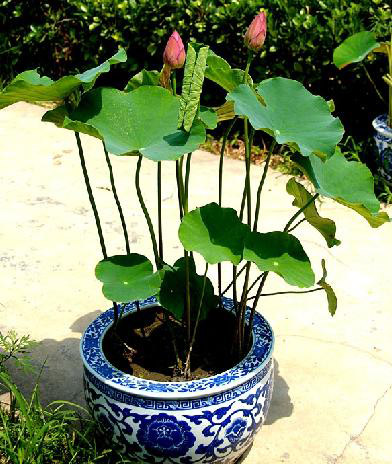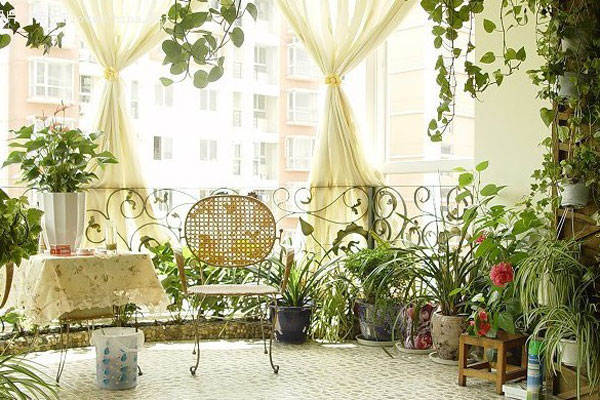Cultivation and management methods of lotus
Lotus, alias Lotus, hibiscus, Ganoderma lucidum, June Spring and so on. The genus Nymphaeaceae is one of the most famous traditional flowers in China.

Lotus, also known as lotus, belongs to the genus Nymphaeaceae and is one of the top ten famous flowers in China. Lotus is an aquatic plant, and the whole growth cycle is inseparable from water. Beijing is short of water, and most of the lotus planted in the courtyard are potted. To raise potted lotus well, it is necessary to master the following essentials.
The pot soil and base fertilizer should be chosen carefully. The clay loam rich in humus is the best pot soil for lotus planting, and the impurities should be removed by sieving. In the selection of base fertilizer, the horseshoe piece has long-lasting fertility, but its release is slow, and it usually takes 1 to 2 years to decompose completely; the processed chicken manure has moderate fertility and can be mixed with soil in proportion; horseshoe powder, bean powder and other conditional areas can also be used. Topdressing in cultivation can be made with sesame paste dregs rich in nitrogen, phosphorus and potassium, and applied regularly according to growth strength and pot size in the growth stage to supplement the lack of fertility in the later stage of potted plants.
Potted lotus should be divided into pots every year, and it is appropriate for Beijing area to divide pots around April 5 every year. Varieties and numbers should be recorded when pots are divided to avoid confusion. Pots can choose tile pots, porcelain pots, plastic pots and other types, according to the size of the pot to determine the number of planted lotus root, generally 40 to 50 cm in diameter of the pot can grow 2 medium-strong lotus roots.
The cultivation place of potted lotus should be leeward to the sun, sufficient water, and determine the location before planting, so as not to affect the germination and growth of lotus root.
The strong lotus root with full terminal bud and no decay damage should be selected for planting lotus root, and it is better to have 2 to 3 nodes. When planting, dig the soil along the basin wall, put the seed lotus root head down, tilt it at a 30-degree acute angle, cover the soil shallow rather than deep, fix the seed lotus root, and expose the "tail" of the seed lotus root to facilitate germination and whip running. After planting, the first watering should be thoroughly, but it should not be too much. The highest temperature in Beijing in May is about 20 ℃. In order to increase the water temperature, the water depth should be less than 5 cm of basin soil, and then it can be deepened gradually with the increase of temperature. The hot summer water should be poured, even twice a day. Watering time should be chosen in the morning and evening, avoid watering at noon.
The lotus begins to bloom in June and blooms from the end of June to the beginning of August in Beijing. In September, the lotus begins to bear lotus roots and store nutrients for overwintering. In October, the stems and leaves in the pot begin to wither and yellow, and the yellow leaves can be cut off in time. The planted lotus root must be stored before winter in Beijing to prevent frost injury. The storage place can be a cold cellar or a cold shed. To keep the basin soil moist and free from freezing, and the temperature is controlled between 0 ℃ and 4 ℃, the planted lotus root can be kept intact.
Key points of cultivation and management techniques of lotus, also known as lotus, water bloom, hibiscus, jade ring and so on. It belongs to perennial aquatic herb flowers of Nymphaeaceae. The underground stem is long and thick, with long nodes and round leaves. Florescence from June to September, solitary born at the top of the pedicel, petals most, embedded in Huatuo hole, there are red, pink, white, purple and other colors, or colorful text, edge. Nuts oval, seeds ovate. There are many kinds of lotus, which can be divided into two categories: ornamental and edible.
Lotus is full of treasure, lotus root and lotus seed are edible; lotus seed, rhizome, lotus root node, lotus leaf, flower and seed germ can be used as medicine to treat a variety of diseases.
The cultivation and management techniques of lotus are briefly introduced as follows:
1. Cultivation environment. The lotus should be planted in still water, which requires that the soil layer of the pond is deep, the water flow is slow, the water level is stable, the water quality is not seriously polluted, and the water depth is less than 150 cm. Lotus is a strong positive flower, so the planting site must keep more than 10 hours of light every day. In addition, lotus is easily swallowed by fish, so harmful fish in the pond should be removed and fenced in before planting to prevent fish from invading.
2. Water at the right time. The water requirement of lotus varies from stage to stage of growth. Generally speaking, only shallow water is needed in the early stage of growth, full water in the middle stage, and less water in the later stage.
3. Rational fertilization. When planting lotus in cylinder basin, bean cake and chicken feathers are generally used as base fertilizer. To make base fertilizer, chicken feathers should be fully mixed with soil. The content of soil and organic fertilizer is 2 ∶ 1, and the amount of base fertilizer is 1 ∶ 5 of the whole planting soil. Put base fertilizer into the bottom of cylinder basin. In the flowering and growing period of lotus, if the leaf color is yellow, urea or compound fertilizer should be used for topdressing, 20 to 60ppm iron-manganese solution can also be used for leaf spraying, or 2ppm can be used for irrigation. Zi lotus generally applies 3000 kg of organic fertilizer and phosphorus and potassium fertilizer per mu as base fertilizer, and the principle of topdressing is light application at seedling stage, heavy application at bud formation stage, and frequent application at flowering and fruiting period. the specific time is as follows: 30 kg phosphorus and potassium fertilizer per mu and 10 kg urea per mu in early May, and flowering stage from mid-June to early August. In order to make the lotus bloom and improve the seed setting rate, topdressing should be applied every 20 days. The lotus root applies 400 kg organic fertilizer per mu and 100 kg bean cake as base fertilizer. The first topdressing of lotus root was in early June, and the standing leaf fertilizer mainly composed of urea and phosphorus and potassium fertilizer was applied in the first ten days of June, and the second time in early July, 30 kg urea and 50 kg phosphorus and potassium fertilizer were applied to ensure more lotus roots, good lotus roots and improve economic benefits.
4. Ploughing and weeding. Weeds are harmful to the growth of lotus, so they should be removed in time. Herbicides should be sprayed once a month in the lotus cultivation garden to control the growth of weeds. Weeds, water moss and algae in the cylinder basin should be removed manually in time. The lotus and seed lotus planted in the field and pond should start ploughing 20 days after planting, that is, after the standing leaves grow 3 to 5 pieces, turn the soil surface to remove weeds, once every half a month, generally ploughing 3 times, and stop when the underground stems basically grow all over the fields and ponds.
5. Pest control. In the whole growth process of lotus, it is very important to control its diseases and insect pests. The main diseases and insect pests are: Spodoptera litura, aphids, beetles, yellow moth, big coir moth, lotus brown spot, lotus rot and so on.
- Prev

How to raise Fu Lukao
Fu Lukao is called Fuluhua, Fuluhua and five-colored plum. Native to southern North America, it is widely cultivated all over the world. Annual herbs, not cold-resistant, like warmth, avoid extreme heat. The flowering period is longer, the seeds are propagated, and the soil cover should not be too thick when sowing, and it is better to be slightly transparent. The optimum temperature for germination is 15-20 degrees Celsius.
- Next

What do you need to pay attention to when growing flowers in summer
Every summer, it is difficult for many flowers to endure. The rainy season of high temperature, hot heat and stagnant water is difficult for them to tide over. First of all, it should be noted that plants should not be exposed to high temperatures for a long time. Different flowers and even different periods of the same flower have different requirements for light.
Related
- Fuxing push coffee new agricultural production and marketing class: lack of small-scale processing plants
- Jujube rice field leisure farm deep ploughing Yilan for five years to create a space for organic food and play
- Nongyu Farm-A trial of organic papaya for brave women with advanced technology
- Four points for attention in the prevention and control of diseases and insect pests of edible fungi
- How to add nutrient solution to Edible Fungi
- Is there any good way to control edible fungus mites?
- Open Inoculation Technology of Edible Fungi
- Is there any clever way to use fertilizer for edible fungus in winter?
- What agents are used to kill the pathogens of edible fungi in the mushroom shed?
- Rapid drying of Edible Fungi

